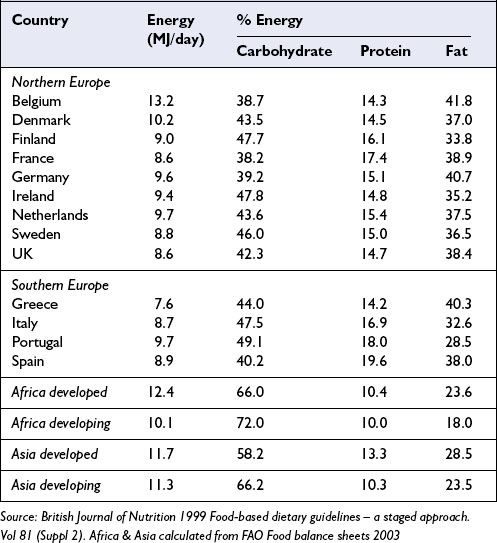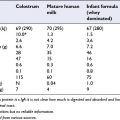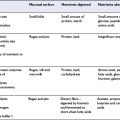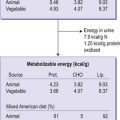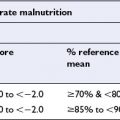CHAPTER 3 Food Consumption
By the end of this chapter you should be able to:
• identify the main sources of nutrients in Western diets
• understand the purpose of additives in food processing
• describe the main types of natural toxins, pollutants and pathogenic agents
• appreciate the similarities and variability in food and nutrient patterns in different population groups and countries
• describe the different types of vegetarian diets
• identify the nutrients most likely to be lacking from vegetarian diets
• understand how the health of vegetarians/vegans differs from those of omnivores
• understand the social, psychological, geographic and economic factors determining food choices and diet patterns
• be aware of changing trends over time including novel foods
3.2 MAJOR FOOD GROUPS IN THE WESTERN DIET
Western diets are composed of several food groups that provide all the nutrients and non-nutrients for optimum health, including cereals and cereal products (eg bread); vegetables and fruit; roots and tubers; milk and other dairy products; meats, fish, eggs and other sources of protein; fats and oils. The food intake patterns for British adults are shown in Table 3.1. The non-nutrients discussed in this chapter include those for which there is evidence for a beneficial effect on human health, as well as other non-nutrients in foods such as contaminants, allergens and food additives that do not have specific health benefits.
Table 3.1 Food intakes among British adults
| Food group | Foods | g/day |
|---|---|---|
| Cereal | White bread | 64 |
| Wholemeal bread | 28 | |
| Other bread | 13 | |
| Pasta and rice | 34 | |
| High-fibre breakfast cereals | 15 | |
| Other cereals | 5 | |
| Potatoes (not fried) | 68 | |
| All starchy foods | 227 | |
| Dairy | Whole milk | 162 |
| Reduced fat milk | 62 | |
| Cheese and dairy desserts | 28 | |
| All dairy products | 253 | |
| Meat, fish, etc | Meat and poultry | 165 |
| Eggs | 25 | |
| Fish and shell fish | 30 | |
| Nuts and pulses | 18 | |
| All meats and alternatives | 238 | |
| Vegetables and fruit | Vegetables | 143 |
| Fresh fruit | 59 | |
| Canned fruit and other fruit | 77 | |
| All vegetables and fruit | 279 |
Data from Gregory et al 1990
Nutritional importance of major foods and food products in the Western diet
Cereals and cereal products
The major cereals in the human diet are wheat and rice followed by maize, barley, oats and rye. Cereals are the staple foods in almost all populations. Carbohydrates form the major part of the cereal grain and consequently these are often referred to as carbohydrate foods. Cereals represent the most important plant foods in the human diet for their contribution to energy and carbohydrate intake and their micronutrient content. In developed countries, such as the UK, cereals provide approximately 30% of the energy intake whilst in developing countries they contribute as much as 70% or more. In the UK, cereals also provide about 10% of dietary fat, 25% of protein and 50% of available carbohydrates. They also make a significant contribution to dietary fibre as non-starch polysaccharides (NSP). They contribute over 40% and 30% of iron and folate intakes respectively – especially breakfast cereals which contribute 20% and 15% respectively.
Roots and tubers
Roots and tubers are the underground organs of many plants:
• Root crops (eg turnips, beetroots): Most roots have high water content and tend to be rich in carbohydrates as free sugars (with small amounts of starch in mature organs). They are generally low in dietary fibre, protein and micronutrients.
• Tubers (eg potato): Tubers are not true roots but rather underground stems that store large quantities of carbohydrate – usually starch. The potato is a stem tuber native to the Andes. All contain large amounts of starch and significant amounts of vitamin C and their high levels of consumption makes them an important source.
Fish
While fish catches worldwide are on the increase according to FAO (Food & Agriculture Organization of the UN), fish stocks are being depleted due to over-fishing. The main sea-food consumed is white fish, oily fish and sea-food invertebrates. Fish are an important source of good quality protein and are low in fat (except for the oily fish which provide a very good source of long-chain polyunsaturated fatty acids – PUFA). Fish are also a major source of iodine which has been accumulated from their environment. Also, they may be an important source of calcium (in fish with fine bones) and vitamin D.
Food sources of nutrients and health related non-nutrients
The importance of specific foods to the nutrient intake of a group in the population depends both on the nutrient composition and the frequency and level of consumption. In the UK population cereals and cereal products, including cakes and biscuits, are the important sources of carbohydrate. Meat, fish, eggs and dairy products are the main sources of protein and fat, whilst fruits and vegetables supply dietary fibre and various vitamins and minerals. Table 3.2 summarizes the macronutrient content of selected foods.
Fruits, vegetables, grains, legumes, nuts and teas are rich sources of phytonutrients (see chapter 5). Phytonutrients (also called phytoprotectants), while not regarded strictly as nutrients, may have certain health benefits. They are extremely varied in their chemical composition, the plants in which they are found and their putative beneficial effects. There are tens of thousands of phytonutrients in plants that have not yet been tested for health benefits. A diet rich in a variety of plant foods (of different colours) ensures a good intake of phytonutrients. Polyphenols are a group of phytonutrients present in onion, apple, tea, red wine, red grapes, grape juice, strawberries, raspberries, blueberries, cranberries, and certain nuts; they are also known as secondary plant metabolites. Much of the total antioxidant activity of fruits and vegetables is related to their phenolic content.
Contribution of macronutrients to energy needs
Patterns of consumption of the macronutrients have changed radically from our ancient ancestors where the relative contribution to energy of these macronutrients has been estimated as 34% protein, 45% carbohydrate and 21% fat, contrasting to that of a typical current Western diet of 15% protein, 46% carbohydrate and 39% fat. In the developing countries such as in Asia and Africa protein levels are lower (10%), carbohydrates higher (60–70%) and fats considerably lower (20%) (Table 3.3). The currently acceptable (ie healthy) macronutrient distribution ranges (AMDR) are 10–15% of energy from protein, 25–30% of energy from fat and 45–65% of energy from carbohydrate.
• Food groups that provide nutrients in the diet are cereals and cereal products; vegetables and fruit; roots and tubers; milk and other dairy products; meats, fish, eggs and other sources of protein; fats and oils
• Non-nutrients in food include those considered to have a potentially beneficial effect on human health such as natural phytoprotectants, as well as food additives that do not have specific health benefits, and toxins and pollutants that are detrimental to health
• In a typical Western diet the percentage of total energy provided by protein is about 15%, carbohydrate 46% and fat 39%
• In developing countries these percentages are typically protein 10%, carbohydrate 60–70% and fat 20%
• Current guidelines for the contribution to energy intake are 10–15% for protein, 45–46% for carbohydrate and 25–30% for fat
3.3 EFFECTS OF FOOD PROCESSING AND STORAGE
Types of food processing
Cooking processes such as roasting, boiling, baking, frying and fermentation have been used for thousands of years. Preservation processes such as salting or drying in air have also been applied for hundreds of years. Many of these methods result in losses of nutrients through leaching of water soluble vitamins or oxidation, especially of vitamin C. Modern industrial processes have been developed to maintain or improve flavour, texture, and nutritional or other quality aspects. Preservation techniques have been improved so as to increase the shelf life of products, whilst maintaining optimal quality. These include pasteurization, canning, refrigeration and freezing, freeze drying, irradiation and high pressure processing. The modern methods result in less loss of nutrients. Industrial processing techniques are focusing more on producing healthy foods without loss of palatability, such as foods with lower fat or salt content.
Food additives
Colours. The classes of natural or nature-identical colourings used for food include carotenoids, chlorophyll, anthocyanins and betalaines. Besides these, some synthetic compounds are allowed for addition to food. Most concern has been expressed about tartrazine.
Stay updated, free articles. Join our Telegram channel

Full access? Get Clinical Tree



